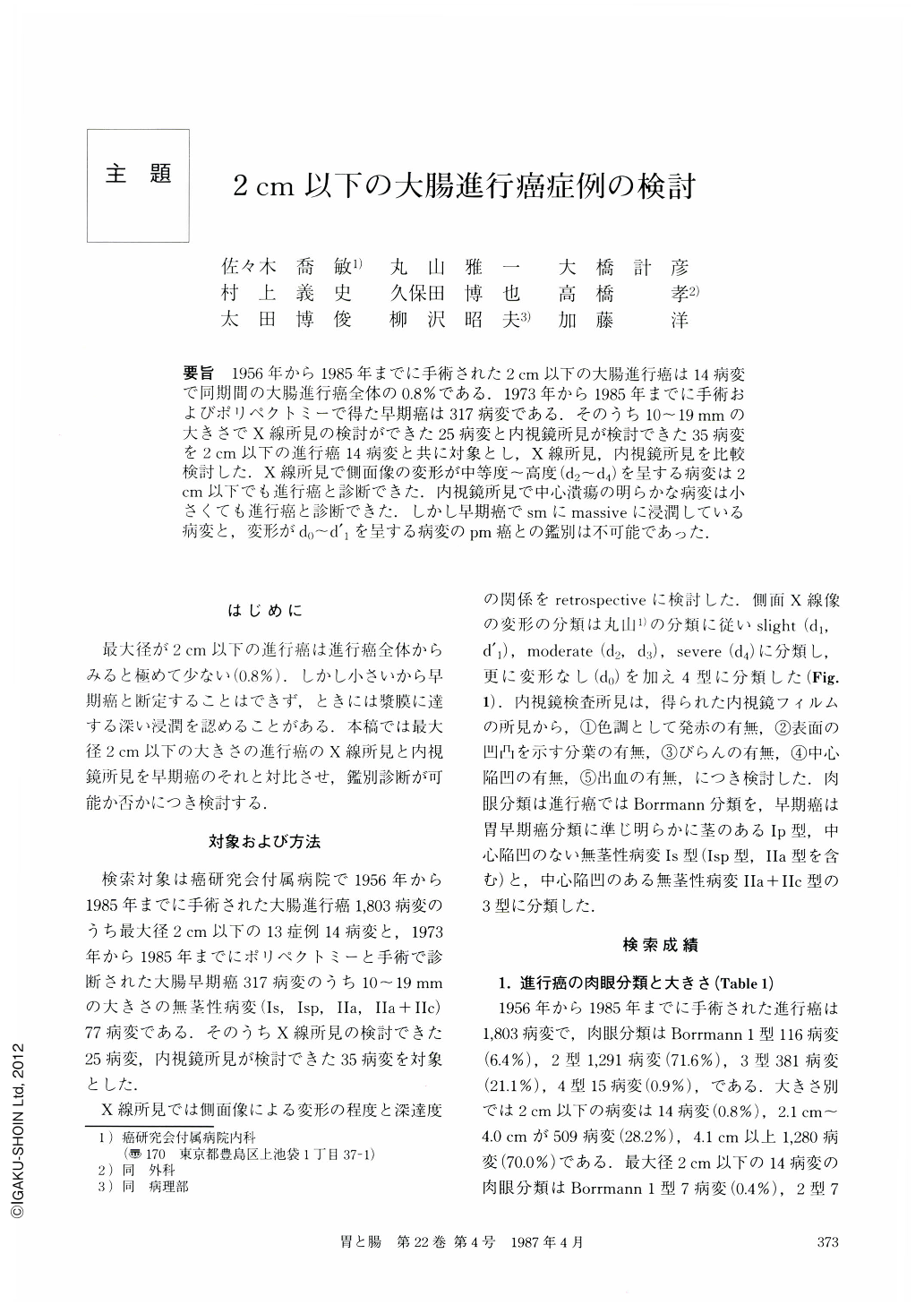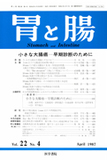Japanese
English
- 有料閲覧
- Abstract 文献概要
- 1ページ目 Look Inside
要旨 1956年から1985年までに手術された2cm以下の大腸進行癌は14病変で同期間の大腸進行癌全体の0.8%である.1973年から1985年までに手術およびポリペクトミーで得た早期癌は317病変である.そのうち10~19mmの大きさでX線所見の検討ができた25病変と内視鏡所見が検討できた35病変を2cm以下の進行癌14病変と共に対象とし,X線所見,内視鏡所見を比較検討した.X線所見で側面像の変形が中等度~高度(d2~d4)を呈する病変は2cm以下でも進行癌と診断できた.内視鏡所見で中心潰瘍の明らかな病変は小さくても進行癌と診断できた.しかし早期癌でsmにmassiveに浸潤している病変と,変形がd0~d′1を呈する病変のpm癌との鑑別は不可能であった.
The subjects were 14 lesions of advanced carcinoma smaller than 2 cm in maximum diameter among 1,803 lesions of advanced large bowel carcinoma operated at Cancer Institute Hospital during the period from 1956 through 1985, while those for early cancer were 77 lesions measuring 10 to 19 mm in diameter without stalks (type Ⅰs, Ⅰsp, Ⅱa, Ⅱa+Ⅱc) among 313 lesions resected or polypectomized at Cancer Institute Hospital during the period from 1973 through 1985.
Of the 77 lesions of early carcinoma, 25 lesions and 35 lesions were included for radiological and endoscopic comparisons, respectively.
The degree of indentation of advanced cancer ranged from d0 (no indentation) to d3 (moderate) among the carcinomas penetrating into proper muscle, and from d2 (moderate) to d3 in those penetrating into subserosa and serosa. In no case is shown d4 severe indentation.
Majority of the carcinomas classified into Borrmann type 1 had d1 and d2, and the ones into Borrmann type 2 tended to have d3 as well as d1 and d2 indentation.
Most of the early cancers showed no (d0) or slight (d1, d′1) indentation, if any. Moderate to severe indentation (d2 to d4) were never observed in the early cancers.
Endoscopic findings were not distinctive enough to differentiate advanced carcinoma of Borrmann type 1 smaller than 2 cm from early cancer of type Ⅰs. Lesions with obvious ulcer formation, however, were diagnosed as advanced cancer almost without fail. Borrmann type 2 carcinomas larger than 2 cm were easy to diagnose by endoscopy.
Thus, the following conclusions were obtained.
1) The 14 lesions of advanced carcinoma, smaller than 2 cm in diameter, of the large bowel were either Borrmann type 1 or type 2 cancer.
2) Lesions with deep central depression detected by radiology and endoscopy, i.e., lesions with obvious ulcer formation, were correctly diagnosed as advanced cancer even though they measured smaller than 2 cm.
3) Lesions with moderate to severe indentation (d2 to d4) in the profile view by x-ray examination were diagnosed as advanced cancer even though they measure smaller than 2 cm.
4) It was difficult to differentiate early cancer with massive penetration into submucosa from advanced cancer with partial penetration into proper muscle without any indentation.

Copyright © 1987, Igaku-Shoin Ltd. All rights reserved.


